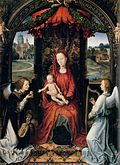Mill (symbol)
The mill is an artistic symbol of the Middle Ages and early modern times. It shows the " essential transformation " of the grain into flour in the holy mill , that is, the renewal of the divine covenant from the old - to the new testament . The reverse of the symbol is the infamous mill , which indicates depravity and sinfulness.
Interpretation and reception
The sacred or mystical mill, also known as the sacrament mill or the host mill , is a well-known example of Christian allegory (meaning behind the wording) and first appeared in the 12th century. The interpretation refers to the Gospel of John (6.51), there Jesus says: I am the living bread that came down from heaven. and later: (12, 24) If the grain of wheat does not fall into the earth and die, it remains alone; but when it dies it bears abundant fruit. The grain of wheat symbolizes the word of the ancient prophets, from which milling becomes the flour from which the host is baked. At the beginning of the 14th century, the poet Barthel Regenbogen calls the world a “riddle mill” and Jesus a “noble miller” in it.
In the 15th century, the positive importance of the mill gradually shifted to Mary, the Mother of God . Since then, such buildings have appeared in the background of images of the Virgin Mary. However, the meaning of a symbol is based on the opposite sense. In Hans Memling's “Triptych of Earthly Vanity and Heavenly Redemption”, a naked lustful woman can therefore be seen between death and the devil as “vanity”, with a disreputable mill on the right .
etymology
The German word mill (for water mill) was borrowed from the late Latin molina (ahd : mulin or muli ) and gradually replaced the older Germanic name quirn [a] (ahd.) Or kürn (mhd.) For hand mill.
The ancient Greek mýllein means grind , compress lips or figuratively have sexual intercourse . The related myllós denotes female shame.
See also
supporting documents
- ↑ ( Joh 6,51 EU )
- ↑ ( Joh 12,24 EU )
- ↑ a b Anita Albus : The art of the arts. Memories of painting. Eichborn, Frankfurt am Main 1997, ISBN 3-8218-4461-2 , p. 143 ff.
- ↑ Duden, dictionary of origin. Etymology of the German language. 3rd, completely revised and expanded edition. Dudenverlag, Mannheim et al. 2001, ISBN 3-411-04073-4 , p. 542.
- ↑ Anita Albus: The art of the arts. Memories of painting. Eichborn, Frankfurt am Main 1997, ISBN 3-8218-4461-2 , p. 151 f.


